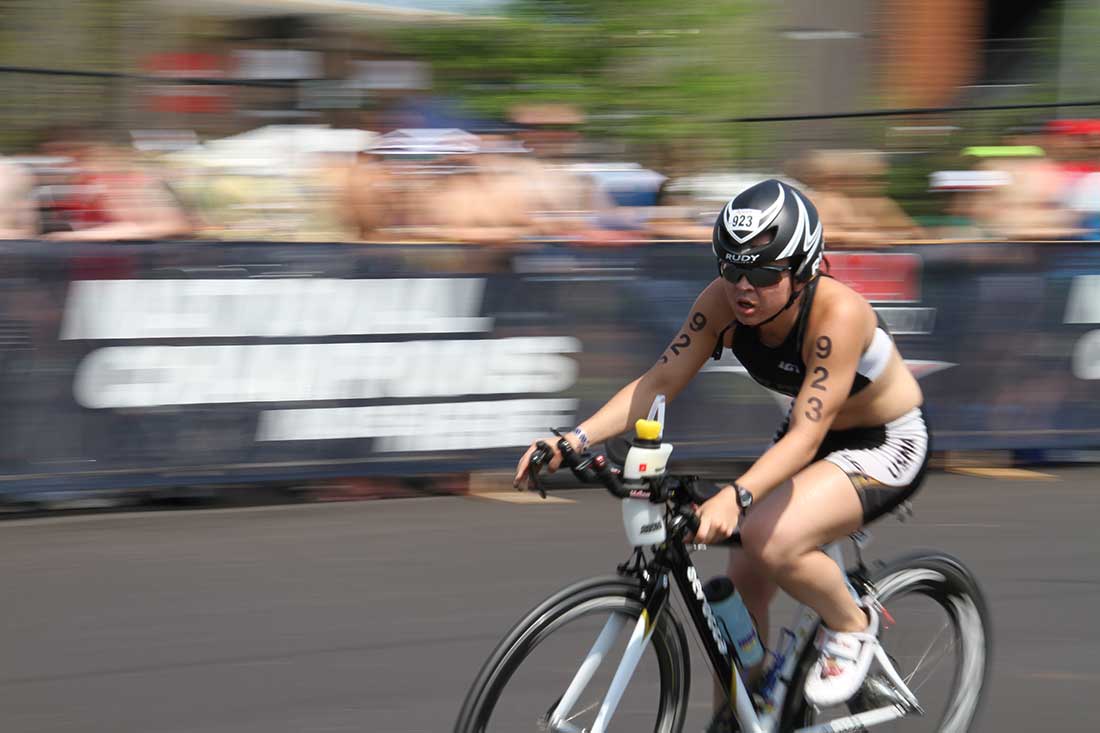By Kathleen McAuliffe
In 2010, triathlon became Meredith Atwood’s “escape from reality.”
For the attorney and mother of two toddlers, intense workouts became a rare source of peace. Some mornings, it was a 10-mile run. Other mornings, it was a 45-plus mile bike ride or a 1300-meter swim (or 26 lengths of an Olympic pool), or a few planks just for fun- and in preparation for a triathlon.
“I was working myself to the bone and commuting all the time and didn’t have anything that felt legitimately mine,” Atwood said. “I was drawn to [triathlon] because it gave me some time away from work and the kids.”
Atwood is just one of thousands of women entering the historically male-dominated sport of triathlon. In 2015, 37 percent of USA Triathlon (USAT) triathletes were women, up from only 20 percent in 2000. Of registered women triathletes, over 53% are between 30-50 years of age.
The sport has drawn both former NCAA athletes, like 2016 Olympic gold medalist Gwen Jorgensen, and women like Atwood.
“[Triathlon] was an elite sport ten years ago and someone overweight or coming off the couch would never consider doing it. But now you’re seeing more women like myself,” said Atwood, now a USAT-certified coach. The sport attracts many non-athletes, including Atwood.
Overweight and inexperienced in fitness, she was initially tested -and humbled- by the sport’s steep physical demands. But beyond simply completing a triathlon, Atwood finished her first Ironman- a 2.4-mile swim, 112-mile bike and 26.2-mile run- in June 2013, an experience she describes as painful but empowering.
“I learned that I am stronger than I ever thought possible,” Atwood said on her blog,” I can’t believe that I went the entire race without wanting to quit. My body wanted to. I could hear it whimpering,’ Dear God, please stop this insanity,’ but my mind was so much louder.”
So why are women taking on this physical and mental challenge? For most, triathlon is a vehicle for personal development and social connection, not weight loss. In one 2011 University of New Mexico study, women triathletes reported that they were more motivated by achieving goals and personal fulfillment than by caloric burn or health concerns.
“It gives you courage, mental toughness and self esteem. It makes you a better person,” said M.J. Gasik, an Ironman competitor and USAT-certified triathlon coach based in Homer Glen. “If everybody got what I did out of triathlon, they would do it too.”
But despite their growing attraction to triathlon, women remain underrepresented in the sport, particularly at the Ironman distance. Only 20 percent of Ironman competitors are women, and the record for highest female participation at an Ironman event is 31 percent. For many women, the limiting factor seems to be time.
Jayme McGuire, Magazine and Digital Media Manager of USA Triathlon, acknowledged that family life can deter some women from longer distances.
“Some women might be taking a break [from training} and coming back later,” she said.
A typical Ironman training plan features six months of twice-daily workouts, including 100-mile training rides and travel to practice sessions on the race course, a difficult balance for any athlete. Mothers in particular struggle to balance the required 15-20 hours of weekly training with childcare, Gasik said.
“Family comes first. There’s no way you can go out and do a workout if you’re worried about your kid getting picked up from school or getting fed,” Gasik said. “The spouse has to be supportive or [athletes] have to have some support system in place, otherwise it’s never going to work.”
But as the women’s triathlon community grows, its leaders are establishing those support networks.
In 2014, Ironman and Lifetime Fitness launched Women For Tri, an initiative working toward equal gender representation in triathlon. It awards grants to emerging female-only tri clubs and female college triathletes and holds all-female group swims and speaking seminars at races. On its Facebook group, more than 23,000 women share tips on training, family and gear recommendations.
The movement’s main goal is to diversify a traditionally male-dominated sport for women of all ages and abilities.
“Through these initiatives, we’ve created safe spaces to let women know that they can try this sport,” Atwood, a Women For Tri board member, said.
And once they experience the sport, women are sharing that support with others, said Alicia diFabio, triathlete and author of upcoming book ”Women Who Tri: A Reluctant Athlete’s Journey into the Heart of America’s New Obsession”.
“After I did my first triathlon, my subsequent races were all about helping someone else do their first,” she added. “I actually enjoy giving moral support to a friend, helping them get through their first race and feel that ‘finish-line pride,’ more than anything else.”

